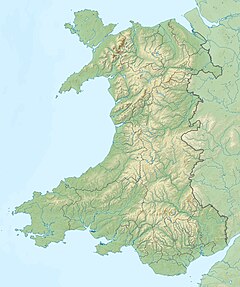Point of Ayr

Point of Ayr lighthouse, at Talacre beach
|
|
|
Wales
|
|
| Location |
Talacre Wales United Kingdom |
|---|---|
| Coordinates | 53°21′25″N 3°19′20″W / 53.357044°N 3.322174°WCoordinates: 53°21′25″N 3°19′20″W / 53.357044°N 3.322174°W |
| Year first constructed | 1776 (first) 1844 (second) |
| Year first lit | 1883 (Dee lightship) |
| Deactivated | 1844 (first) 1883 (second) |
| Construction | brick tower (first) |
| Tower shape | tapered cylindrical tower with balcony and lantern (first) metal pile lighthouse (second) |
| Markings / pattern | white tower, black lantern, red lantern dome (first still up) |
| Height | 18 metres (59 ft) (first) |
| ARLHS number |
WAL-018 |
WAL-018
Point of Ayr (Welsh: Y Parlwr Du) is the northernmost point of mainland Wales. It is situated immediately to the north of Talacre in Flintshire, at the mouth of the Dee estuary. It is to the southwest of the Liverpool Bay area of the Irish Sea. It is the site of a RSPB (Royal Society for the Protection of Birds) nature reserve RSPB Dee Estuary Point of Ayr, and is part of Gronant and Talacre Dunes Site of Special Scientific Interest.
For many years a colliery operated at Point of Ayr at the northern extremity of the Flintshire Coalfield; it was one of the last remaining operational deep mines in Wales. The first trial borings took place in 1865, under the direction of Lord Mostyn, owner of Mostyn Colliery, a few miles away. The borings seemed successful, and the Prestatyn Coal Company was formed to commence operations proper, however the project was abandoned before it got off the ground. In 1873, the site was investigated a second time, by a newly formed company, the Western Mostyn Colliery Company, however the trial shaft was not successful, and the project was again abandoned.
In 1883, a third company was formed, the Point of Ayr Colliery Company, and in 1890 they struck a seam. Coal at this time was brought to the surface by a team of 75 pit ponies. A second shaft was also sunk around this time. According to the Inspector of Mines records, in 1896 the pit employed 356 men producing coal for domestic and industrial uses. A third shaft was sunk sometime after the National Coal Board took over the site following nationalisation in 1947. The coal field extended northwards under the Irish Sea. By 1953, 738 men were producing 213,000 tons of coal annually. Point of Ayr colliery closed on 23 August 1996. Nothing now remains of the colliery, not even a memorial plaque. However, like many former coal mines, the name is retained by "Point of Ayr Colliery Band", a Brass Band competing at Championship level.
...
Wikipedia

